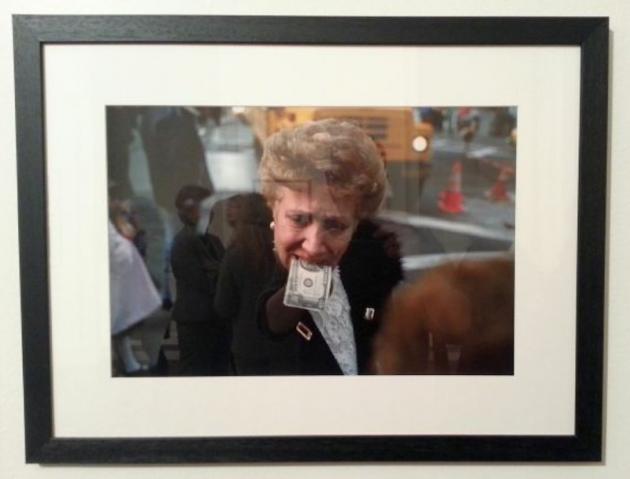An interesting premise here, as curator William E. Ewing challenges the legacy of Henri Cartier Bresson’s ‘decisive moment’ through a survey of post-war, pre-conceptual colour photography, as well as some more recent examples. Cartier-Bresson hated colour, as did many, for black and white was considered the higher status approach until the sixties and seventies, but rather than disrespect the most respected of photographic legends, this show tips its hat by demonstrating his far-reaching influence. The resultant show is a classy selection of some under-represented masters alongside the more well known of Cartier-Bresson’s disciples.
The show is hung around four Cartier-Bresson photographs being shown in the UK for the first time. These are wonderful, but hung around them is some equally outstanding imagery. Saul Leiter’s beautiful abstractions; all refractions, reflections and stolen fragments are photography as a graceful abstract expressionism. His is the city as canvas, with which to construct relationships in line, form and colour, but only insofar as a pictorialist essence is retained. Leiter’s recent Steidl publication, ‘Early Color’ has sold out 2 editions and it is easy to see how this member of ‘The New York School’ of the 40’s and 50’s was instrumental in bringing colour photography to the towards acceptance.
Another early colour pioneer, though influenced by Cartier-Bresson more directly, is Vancouver native, Fred Herzog. Seminal in his own country, Herzog has only recently began to receive the international recognition he deserves. Using mainly Kodachrome (legendary colours slide film, now discontinued) in the 50’s, Herzog made many pictures of his city that seem to highlight a Hopper-like loneliness across its wide, empty boulevards. As opposed to Cartier-Bresson, who more often froze action, or distilled moments of dynamic interaction between form and content, Herzog freezes the pause, the moment of contemplation or even the distances between people.
Images from Ernst Haas’s Colour , a publication and series of exhibitions collecting much of the outstanding, observational work that Haas was himself unwilling to show, due to snobbish accusations of commercialism from the establishment, despite being both a Magnum photographer (an agency Cartier-Bresson helped set up) and widely recognised as a pre-eminent image-maker. No other photographer on show loves colour as Haas did in these images. These images reveal a joy unbridled in colour; the interstices in which an element, or a moment, are highlighted by the convergence of light and shadow. Haas’s images truly reveal a sense of wonder.
More predictable inclusions, though no less significant, are Joel Meyerowitz, with some images form his masterpiece ‘Intersections’ series, and the great street- work of Helen Levitt. It’s nice to see some Robert Walker too, who though less subtle than some other artists here, was also important in pushing the boundaries and acceptance of the use of colour in his medium. The best work from the more contemporary artists can be found in the photographs of Trent Parke, whose vision is meshes the street with the surreal and the cinematic, and the images of Ukrainian Boris Savelev, who captures a cruel grace.
What impresses most about this show, beyond the quality of the artists included and the fact that some of their best images are on display, but the sophistication with which Cartier-Bresson’s influence is explored. The idea of form and content in balance, the idea of the moment that hints at the fabric of our reality, whether it be colour or black and white; that is Cartier-Bresson’s legacy and to this, curator William E, Ewing pays his due respects.
Cartier-Bresson: A Question of Colour, until January 27th @ Somerset House / London
words by Kerim Aytac

